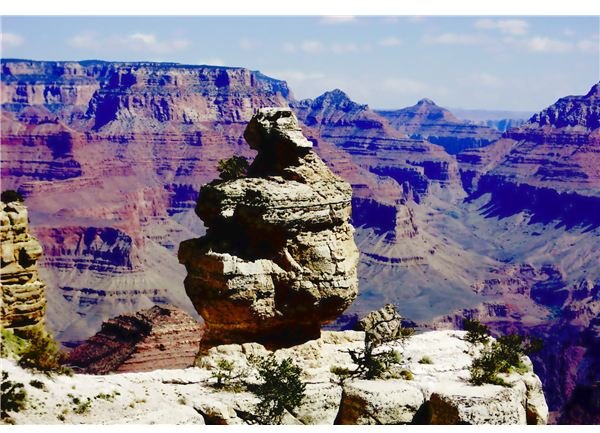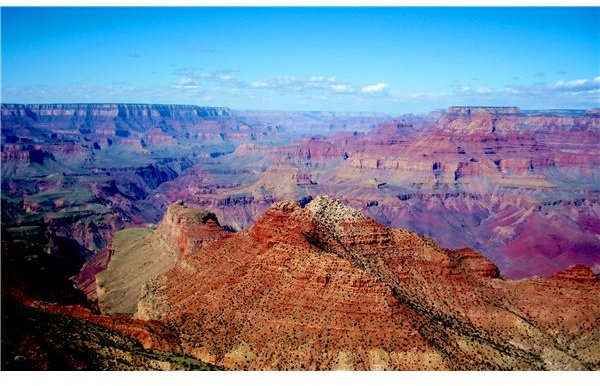Formation of the Grand Canyon: Information, Formation & History of the Grand Canyon
Grand Canyon National Park, Arizona
Grand Canyon National Park of Arizona is recognized today as the world’s greatest natural wonder—attracting more than 5 million visitors from all over the world every year.
Formed by the Colorado River that runs through it, the Grand Canyon spans over a million acres of land or more than 1,900 square miles, and stretches 277 miles long—making it the largest canyon on Earth. At its deepest, one could drop 6,000 feet from the rim of the canyon to the bottom of the river. The greatest width of the canyon spans 18 miles across. However the canyon grows wider, deeper, and longer every day as it weathers to the impact of wind, rain, and the constant meandering of the Colorado River.
Formation of the Grand Canyon Controversy
There are a variety of ideas regarding how the Grand Canyon was formed. It is widely agreed that the Colorado River formed most of it, carving the canyon over millions of years with the help of plate tectonics, geologic uplift, and erosion from wind, rain, and ice. What has yet to be agreed upon is the certain age of the Colorado River- which would shed light upon the age of the Grand Canyon itself.
Traditional geologists of the 1950’s believe the canyon to be more than 70 million years old. They suggest it was formed at the beginning of the Tertiary. The mid-western regions of Colorado, Utah, and Arizona were a mere 1,000 feet above sea level and very hot and humid. Rivers ran wild and abundant. Plate tectonics formed mountain ranges at convergent boundaries which would weather away over millions of years and scatter gravel deposits over the land causing uplift. Over the last 5 million years, the climate changed to the desert of today and the Ancestral Colorado River all but dried up, moving underground or sporadically during seasons of moisture.
Recent geologists, however, have a different idea of how the Grand Canyon was formed—having only formed over the last 5 million years. There seems to be no substantial evidence of the old river system and lakes that would feed the Colorado River of today. While the upper portion of the Colorado River strikes geologists as very old, the sediment of the lower river portion is incredibly new. This leads many geologists to believe the Ancestral Colorado River used to flow a different course, but at some point in the last 5 million years, that course was disrupted and cut off. Then a separate river from the west, that has yet to be named, joined up with the Ancestral Colorado and this new river system was responsible for how the Grand Canyon was formed.
The answer to the question, “What happened to the Ancestral Colorado River?” may lie in the surrounding rock matter of the mysterious Grand Canyon… but tearing into it would mean spoiling the awesome beauty of the world’s greatest natural wonder.
Grand Canyon Culture and History
The Native Americans who call Grand Canyon National Park “home” have occupied the mid-west since 200 BCE (according to ancient adobe ruins, hand-carved figurines, and cave paintings discovered by archaeologists) and are very familiar with the splendor of the world’s greatest natural wonder.
The cultural history of Grand Canyon National Park is rich with legend, magic, and folklore. The Hopi people believed the Grand Canyon to be the opening of the underworld from which their tribe emerged to the surface of the Earth. Rainbow Bridge, a massive sandstone structure emerging from the remote Glen Canyon, was believed by the Navajo to be a bridge to the Sun God created by a deity called Spider Woman to help the twin sons of the Changing Woman reach their father.
Visitors to Grand Canyon National Park can certainly feel the magic in the air. The jaw-dropping majesty of the canyon has dazzled visitors since it became a national monument in 1908. Rock samples taken from the Grand Canyon date back to the Precambrian (more than 2 billion year ago,) and rock layers as well as fossil evidence paint paleontologists a beautiful picture of the Paleozoic era (more than 300 million years ago) to the Mesozoic and Cenozoic (250 million years ago – present.)
A stunning mix of igneous, metamorphic, and sedimentary rocks may be found at the canyon; however, most appealing of all are the famous red rocks that catch fire in the sunlight and burn themselves into memory when you think back on the magnificence of Grand Canyon National Park, Arizona.
If you are planning a trip to Grand Canyon National Park, Arizona, you won’t be disappointed.
Painted Rocks

References
https://www.stuff.co.nz/travel/international/3056126/Grand-rainbow-in-the-canyon
https://grand-canyon-vacation-information.com/hopi-legend.html
